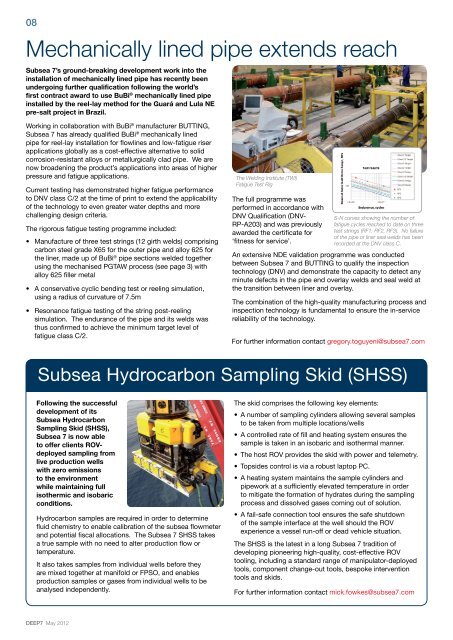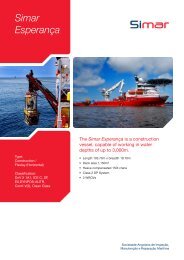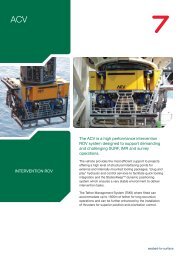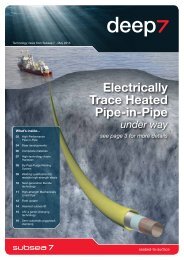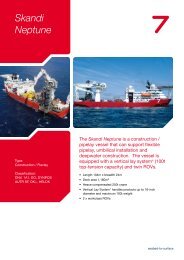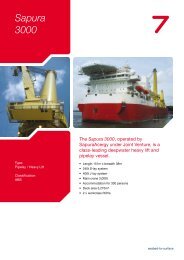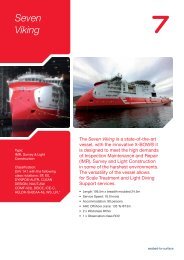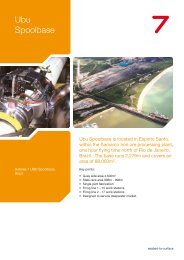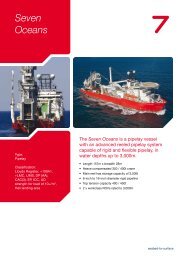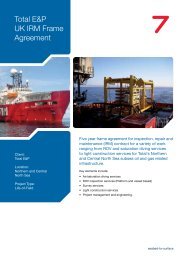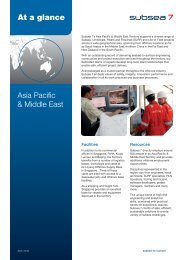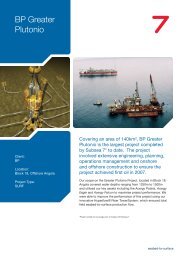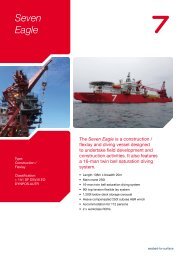World-class welding technologies - Subsea 7
World-class welding technologies - Subsea 7
World-class welding technologies - Subsea 7
You also want an ePaper? Increase the reach of your titles
YUMPU automatically turns print PDFs into web optimized ePapers that Google loves.
08<br />
Mechanically lined pipe extends reach<br />
<strong>Subsea</strong> 7’s ground-breaking development work into the<br />
installation of mechanically lined pipe has recently been<br />
undergoing further qualification following the world’s<br />
first contract award to use BuBi ® mechanically lined pipe<br />
installed by the reel-lay method for the Guará and Lula NE<br />
pre-salt project in Brazil.<br />
Working in collaboration with BuBi ® manufacturer BUTTING,<br />
<strong>Subsea</strong> 7 has already qualified BuBi ® mechanically lined<br />
pipe for reel-lay installation for flowlines and low-fatigue riser<br />
applications globally as a cost-effective alternative to solid<br />
corrosion-resistant alloys or metallurgically clad pipe. We are<br />
now broadening the product’s applications into areas of higher<br />
pressure and fatigue applications.<br />
Current testing has demonstrated higher fatigue performance<br />
to DNV <strong>class</strong> C/2 at the time of print to extend the applicability<br />
of the technology to even greater water depths and more<br />
challenging design criteria.<br />
The rigorous fatigue testing programme included:<br />
• Manufacture of three test strings (12 girth welds) comprising<br />
carbon steel grade X65 for the outer pipe and alloy 625 for<br />
the liner, made up of BuBi ® pipe sections welded together<br />
using the mechanised PGTAW process (see page 3) with<br />
alloy 625 filler metal<br />
• A conservative cyclic bending test or reeling simulation,<br />
using a radius of curvature of 7.5m<br />
• Resonance fatigue testing of the string post-reeling<br />
simulation. The endurance of the pipe and its welds was<br />
thus confirmed to achieve the minimum target level of<br />
fatigue <strong>class</strong> C/2.<br />
DEEP7 May 2012<br />
The full programme was<br />
performed in accordance with<br />
DNV Qualification (DNV-<br />
RP-A203) and was previously<br />
awarded the certificate for<br />
‘fitness for service’.<br />
An extensive NDE validation programme was conducted<br />
between <strong>Subsea</strong> 7 and BUTTING to qualify the inspection<br />
technology (DNV) and demonstrate the capacity to detect any<br />
minute defects in the pipe end overlay welds and seal weld at<br />
the transition between liner and overlay.<br />
The combination of the high-quality manufacturing process and<br />
inspection technology is fundamental to ensure the in-service<br />
reliability of the technology.<br />
<strong>Subsea</strong> Hydrocarbon Sampling Skid (SHSS)<br />
Following the successful<br />
development of its<br />
<strong>Subsea</strong> Hydrocarbon<br />
Sampling Skid (SHSS),<br />
<strong>Subsea</strong> 7 is now able<br />
to offer clients ROVdeployed<br />
sampling from<br />
live production wells<br />
with zero emissions<br />
to the environment<br />
while maintaining full<br />
isothermic and isobaric<br />
conditions.<br />
Hydrocarbon samples are required in order to determine<br />
fluid chemistry to enable calibration of the subsea flowmeter<br />
and potential fiscal allocations. The <strong>Subsea</strong> 7 SHSS takes<br />
a true sample with no need to alter production flow or<br />
temperature.<br />
It also takes samples from individual wells before they<br />
are mixed together at manifold or FPSO, and enables<br />
production samples or gases from individual wells to be<br />
analysed independently.<br />
The Welding Institute (TWI)<br />
Fatigue Test Rig<br />
S-N curves showing the number of<br />
fatigue cycles reached to date on three<br />
test strings (RF1, RF2, RF3). No failure<br />
of the pipe or liner seal welds has been<br />
recorded at the DNV <strong>class</strong> C.<br />
For further information contact gregory.toguyeni@subsea7.com<br />
The skid comprises the following key elements:<br />
• A number of sampling cylinders allowing several samples<br />
to be taken from multiple locations/wells<br />
• A controlled rate of fill and heating system ensures the<br />
sample is taken in an isobaric and isothermal manner.<br />
• The host ROV provides the skid with power and telemetry.<br />
• Topsides control is via a robust laptop PC.<br />
• A heating system maintains the sample cylinders and<br />
pipework at a sufficiently elevated temperature in order<br />
to mitigate the formation of hydrates during the sampling<br />
process and dissolved gases coming out of solution.<br />
• A fail-safe connection tool ensures the safe shutdown<br />
of the sample interface at the well should the ROV<br />
experience a vessel run-off or dead vehicle situation.<br />
The SHSS is the latest in a long <strong>Subsea</strong> 7 tradition of<br />
developing pioneering high-quality, cost-effective ROV<br />
tooling, including a standard range of manipulator-deployed<br />
tools, component change-out tools, bespoke intervention<br />
tools and skids.<br />
For further information contact mick.fowkes@subsea7.com


